Tomatoes
BackTomatoes are one of the most popular of garden edibles to grow and have been cultivated by humans for 1,000’s of years. It might surprise you to learn that they originate from South America and not Spain or Italy.
Now there’s lots to cover when growing super tasty tomatoes so let’s get straight into it!
How to Grow Tomatoes
Tomatoes must be grown in full sun in a nutrient rich, free draining soil. Improve soil quality by adding organic matter before planting (eg compost and aged manures). On clay soils add some gypsum to improve drainage.
Tomatoes are warm season plants and are frost sensitive. If you are in a frosty climate they’ll need protection at the very beginning and end of the growing season. This can be done by covering plants with shade cloth or growing in pots that can be moved easily if frost is forecast.
While there are lots of different types of tomatoes and they can be divided into two categories:
- Indeterminate – climbing types that will need staking or
- Determinate – compact bush forms that don’t require staking and are well suited to pots.
It’s important to know what type you have so if staking is required it’s done straight after planting. This way the roots won’t be damaged by pushing stakes into the soil at a later date.
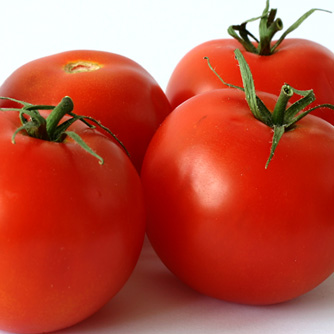
Juicy tomatoes ready for eating
Tomatoes require consistent watering for plant health and fruit development. Periods of drying out and then over watering may cause fruit to split or develop blossom end rot. Water stressed tomatoes will also produce less fruit and be more susceptible to pest and disease problems.
Propagating Tomatoes
Tomatoes can be purchased as seedlings or more advanced plants but they’re also easily started from seed. Growing from seed is a great way to try heirloom varieties not commonly available as seedlings in stores. It can also be a way to get a head start on the season if you keep the seedlings in a protected spot and then plant out after the frosts have finished.
Tomato seeds are almost always sown in punnets or small pots, in regular potting mix, and then planted out when a decent size. Unlike many other seedlings you don’t need to worry about leaving them too long in the punnets before planting. Seedlings which have been “cramped” will start flowering earlier meaning less time to wait for juicy tomatoes!
Please note that tomato seeds require warm soil to germinate so if you are sowing early place them on a heating tray or in a warm spot (like a sunny window sill) to speed things up.
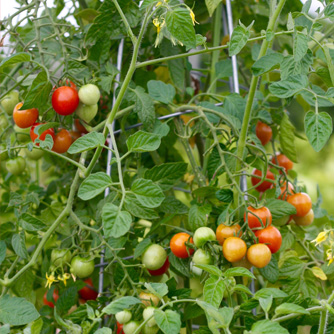
Healthy tomato plant with ripening fruit
Sowing Guide for Tomatoes
| Growing Zone | Sowing Time |
| Cool | Spring, Summer |
| Mediterranean | Spring, Summer |
| Warm & Temperate Frost Free | Autumn, Spring, Summer |
| Tropical & Subtropical | All year round |
Fertilising
Tomatoes are hungry plants and respond well to the soil being prepared with aged manure and compost before planting. Also apply dolomite or lime to ensure there is plenty of calcium available to the plants. If your soil is already the correct pH then use gypsum to boost calcium as it won’t alter the pH.
To really keep your tomatoes charging along we recommend fortnightly liquid feeding with OCP eco-aminogro and OCP eco-seaweed. They’ll produce more flowers and fruit and be more resistant to disease attack and other stress factors. Half way through the growing season boost calcium levels again with a further an application of dolomite, lime or gypsum.
This might sound like a lot but regular feeding is one of the key secrets to success with tomatoes.
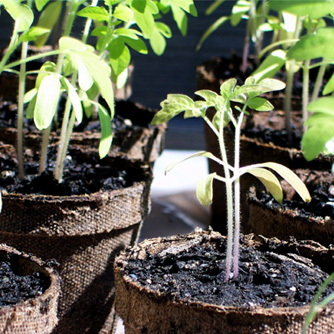
Tomato seedlings not quite ready to plant out
Pruning Tomatoes
Tomatoes that are indeterminate types (climbers) are usually very vigorous and grow quite tall. Pinch off the side shoots (called laterals) to maintain one main leader stem and stop the plant from sprawling all over the place. This makes it easier to stake and protect fruit. No need to worry about this with bush tomatoes (determinate varieties).
With both types remove the older lower leaves as soon as they start to look tatty. This improves air circulation within the plant and helps reduce the risk of diseases taking hold.
Harvesting Tomatoes
Tomatoes can be ready as early as 7-8 weeks (cherry tomato types) but the larger varieties will be closer to 12-14 weeks. As your tomatoes start to colour up you’ll know harvesting time is near. Ripening is actually determined by consistent warm temperatures and not sun exposure. In cool and Mediterranean regions it’s best to pick the end of season green fruits and place them indoors in a warm spot to ripen.
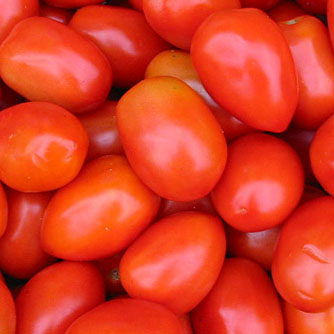
Roma tomatoes with their distinct elongated egg shape
Pests and Diseases of Tomatoes
Unfortunately there is a long list of things which can go wrong with tomatoes. Here are some of the main ones:
- Aphids, mites and whitefly are very common problems but are easily treated with OCP eco-oil. Be sure to spray at the first sign of trouble as numbers very quickly escalate and are then harder to get under control.
- Caterpillars can attack the foliage and fruit. Pick them off as you see them or spray with OCP eco-caterpillar killer.
- Developing fruit can be stung by fruit fly so we recommend hanging the OCP eco-lure trap early to act as a monitoring tool. At the first sign of flies apply an organic bait spray to protect fruit or set up exclusion netting/bags.
- Root-knot nematodes are microscopic worm-like creatures which invade and damage roots. Difficult to control once plants are infected we recommend protecting new plants with OCP eco-nemguard at planting time. Practicing crop rotation and improving the organic content of your soil can also help. Alternatively grow plants in pots with fresh potting mix.
- Blossom end rot will cause the fruit to rot before it ripens and is due to a lack of calcium and/or infrequent watering. Give the plants deep and regular watering and apply one of the high calcium products as mentioned above (dolomite, limie or gypsum) throughout the growing season.
- Split fruit can occur with a surge of watering/rain. The fruit swells faster than the skin can grow resulting in the split. Again maintain frequent and even watering to avoid this. As for the rain well you’re on your own there
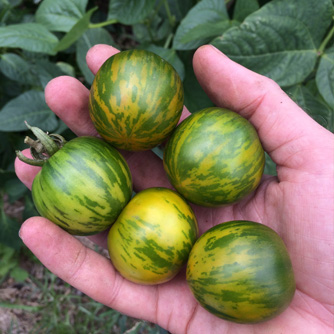
Green zebra tomatoes ready to eat
- Powdery mildew can spread across foliage quickly but is easily fixed with a spray of OCP eco-fungicide.
- There are several other fungal, bacterial and viral wilts which cause plants to wither and die. Many live in the soil and once plants are infected they are virtually impossible to save. It comes back to practicing crop rotation to avoid a build up of pathogens in the soil or growing plants in pots with fresh potting mix.
- be on the lookout for the recently arrived tomato potato psyllid. It's a sap sucking pest from overseas which has so far only been found in WA. Spray OCP eco-oil at the first sign of the pest. Quarantine zones apply within certain WA areas to restrict the movement of plants. If you think you have it outside those areas then it should be reported to your state agricultural department.
This might seem daunting but don’t be put off. If you practice the following cultural tips many of the difficult problems can be avoided:
- Keep plants well fed so they stay healthy and vigorous.
- Water regularly and deeply but avoid wetting foliage if possible (especially in the evening).
- Don’t grow tomatoes or other plants in the same family (capsicums, chillies, eggplants and potatoes) in the same soil year after year. Rotate the crops.
- Prune off old tatty leaves.
- Stake and tie up climbing varieties to minimise foliage contact with the soil.
- Control aphids which can spread viral diseases.
- Control other sap suckers (eg mites and whitefly) as they will weaken the plants.
And our final tip if you’re a novice tomato grower – start with the cherry tomato varieties. They are the easiest to grow and will produce loads of fruit with fewer problems compared to the large varieties.
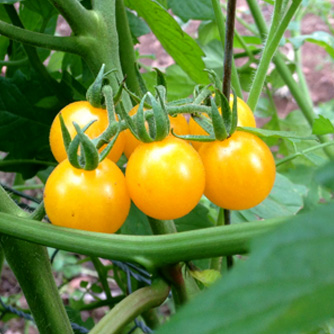
Bright yellow cherry tomatoes
Our Top Tomato Picks
There are literally 100’s of named varieties of hybrid and heirloom tomatoes. We generally prefer the heirloom or heritage varieties because they taste better and usually suffer from fewer pest and disease problems. Plus you can save their seed for sowing again next year (just be mindful of any cross pollination). Here are a few of our favourites:
Green Zebra: yellow mid-size fruit with green stripes. Bears large crops with a creamy texture.
Black Russian: show stopping black/purple fruit that not only look amazing but taste amazing too.
Mortgage Lifter: developed in the Depression and is one of the largest tomatoes in the world (up to 1.6kg each).
Tommy Toe’s Gen Y: this cherry tomato has won numerous best flavour awards in Australia. Once just available in red, it now comes in a speckled bronze, yellow and light pink.
Lemon Drop: delightful yellow cherry fruit that have an amazing fresh tomato flavour.
San Marzano: the ultimate preserving, sauce, paste and Italian cuisine tomato. Similar shape to Roma tomatoes but stronger flavour and less seeds
Grosse Lisse: One the most popular home gardener varieties. Large fruit and a proven winner.
Beams Yellow Pear: vibrant small yellow pear shaped fruit are produced within seven weeks. A delightful addition to the salad bowl.
Granny’s Throwing Tomato: Italy’s favourite tomato can be used for either sauces or salads or throwing apparently!
Amish Paste: rich sweet fruit that is very versatile and can be used in salads and sauces.
All are climbers (indeterminate) so remember to stake them or provide support.
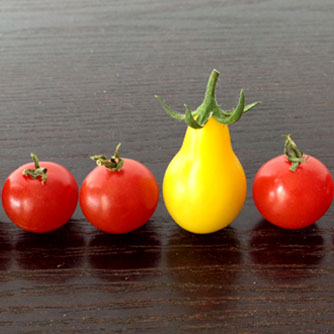
The unusual yellow pear tomato among regular cherry tomatoes


